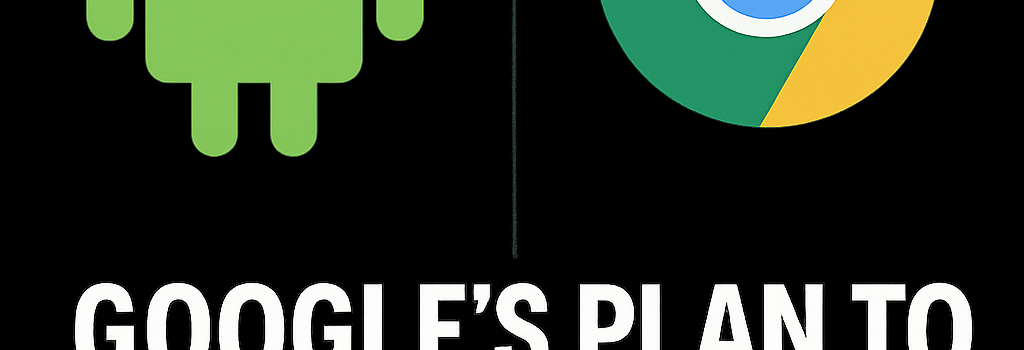Google’s Plan to Merge Android and Chrome OS

Google’s Android Ecosystem President Sameer Samat has confirmed that Chrome OS and Android will be combined into a single platform. While Google remains tight-lipped on specifics, this merger promises to reshape the landscape of personal computing, from entry-level Chromebooks to high-end Android tablets and laptops.
Background: Two Parallel Platforms
Since their debuts, Android and Chrome OS have shared a common Linux kernel heritage but evolved along distinct paths:
- Chrome OS: A Debian-derived distribution optimized for web apps, with a custom Chrome OS kernel, coreboot firmware, verified boot, sandboxed browser tabs, and deep integration with Google Assistant and Drive.
- Android: A mobile-focused OS built atop a heavily modified Linux kernel (version 5.x+), using the Android Runtime (ART), binder IPC, SELinux policies, and Google Play Services for app distribution and updates.
What “Combining” Means
In an interview with TechRadar, Samat stated he’s very interested in how users employ laptops today, hinting at plans for a more versatile platform. Industry analysts speculate on several scenarios:
Unified Kernel and OS Architecture
A single Linux kernel, maintained under Google’s Kernel Next initiative, could serve both mobile and desktop workloads. This would entail merging Chrome OS patches—such as kernel lockdown, KMS/DRM graphics drivers, and Chrome sandbox hooks—into Android’s upstream kernel, or vice versa. Benefits include:
- Fewer divergent code branches and a consolidated security hardening process.
- Consistent driver support for Wi-Fi, Bluetooth, TPM/TPM2, and audio over ALSA/PulseAudio.
- Streamlined OTA updates leveraging Android’s Project Mainline modules.
Hardware Support and Certification
Chrome OS currently guarantees up to eight years of security updates on verified devices, spanning both x86 and ARM architectures. Android’s support window is typically two to three years. A unified platform must reconcile these lifecycles, possibly by:
- Extending Project Treble’s modular architecture to include firmware, bootloader, and Verified Boot components.
- Leveraging virtualization (KVM/QEMU) or containerization (lxd) to run legacy x86 applications on ARM devices.
- Standardizing hardware abstraction layers (HALs) so OEMs produce one certified image across multiple form factors.
Implications for OEMs and Developers
A merged OS could reduce fragmentation and simplify device rollouts. Key impacts include:
- Unified SDK: Developers target one API set for both touch and keyboard scenarios, using Android Studio with integrated desktop windowing and pointer support.
- Simplified Fleet Management: Enterprises manage updates via Google Admin Console, combining Chrome Enterprise policies with Android zero-touch enrollment.
- Cross-Platform App Distribution: One Play Store binary format, plus Progressive Web Apps (PWAs) with deeper system privileges.
Expert Opinions
- Dr. Lina Tran, OS Kernel Specialist: “A unified kernel reduces maintenance overhead, but merging two large patch sets will be a monumental task. Google must ensure real-time responsiveness on mobile while preserving Chrome’s tight security model.”
- Alexei Morozov, Hardware Engineer: “ARM SoCs with integrated NPUs and GPUs could finally shine under a desktop-class Android, offering better battery life than most x86 laptops.”
Potential Challenges and Roadmap
Key hurdles include backward compatibility for legacy x86 Chromebooks, integration of the Verified Boot chain, and driver support. Google’s internal roadmap likely spans 18–24 months, with initial previews in Android 15L and a full rollout in Chrome OS 117 (or the rebranded unified OS) by late 2026.
Additional Analysis: AI and Multi-Device Integration
Combining platforms opens doors for AI features like on-device Gemini and federated learning across phones, tablets, and laptops. Integrated ML accelerators—Edge TPU or Hexagon DSP—could power real-time transcription, smart battery management, and predictive desktop workflows.
Additional Analysis: Security and Update Strategy
A single OS allows a unified security stack: SELinux enforced by eBPF, hardware-backed key storage via Titan C chips, and seamless rollouts with A/B partitions. Google might extend its Security Patch Level to eight years, matching enterprise requirements and outpacing Apple’s iPad update window.
Conclusion
Google’s decision to combine Android and Chrome OS heralds a major platform evolution. By unifying kernels, simplifying hardware support, and leveraging AI, the merged OS could challenge both Windows on x86 and iPadOS on ARM. While many questions remain, one certainty stands: the future of Google’s personal computing ecosystem is about to get a lot more interesting.